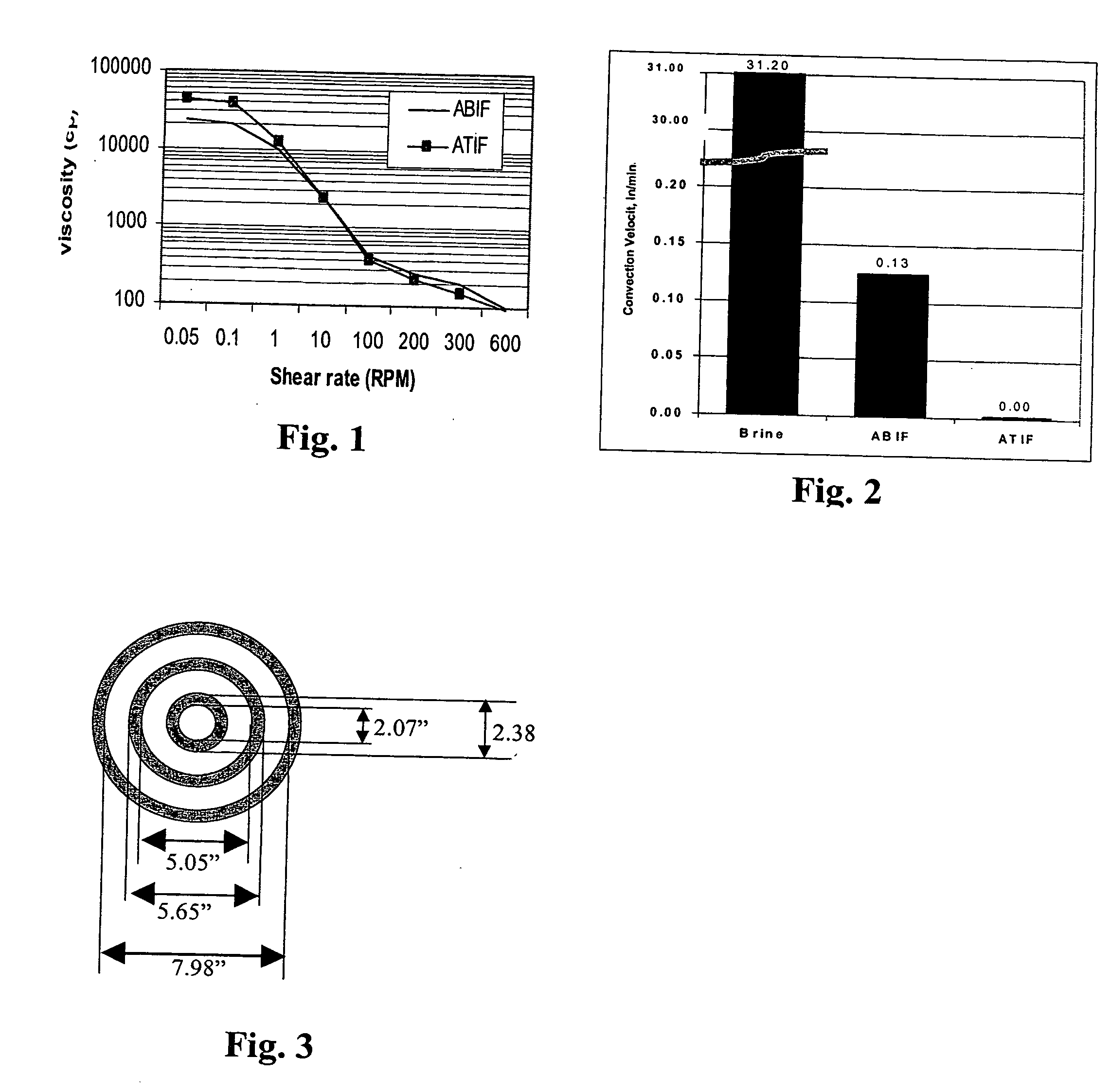Method of using water-superabsorbent polymer in production tubing and pipes
a technology of superabsorbent polymer and production tubing, which is applied in the direction of insulation, sealing/packing, and wellbore/well accessories, etc., can solve the problems of destabilizing the permafrost in arctic type regions, accelerating the formation of gas hydrates, and productivity losses, so as to achieve low viscosity, easy pumping, and high viscosity
- Summary
- Abstract
- Description
- Claims
- Application Information
AI Technical Summary
Benefits of technology
Problems solved by technology
Method used
Image
Examples
example 1
Example 1 Examines the Rheology of an Insulating Fluid of the Invention
[0081] 8 g of carboxymethyl hydroxypropyl guar (CMHPG) and 4 g of superabsorbent polymer G-504 (e.g. Water Lock product from Grain Processing Corp., Muscatine, Iowa) were added to 175 milliliters of propylene glycol under stir. After mixing for 5 minutes, this mixture was added to 525 milliliters of 9.14 lb / gallon sodium bromide brine (final density=1.08 g / ml, or 9 pound / gallon) under rapid agitation.
[0082] After hydrating the mixture by a mechanical stirrer for 30 minutes, the pH was adjusted to about 9.5 with sodium hydroxide.
[0083] Thereafter, a 40 milliliter sample of the hydrated fluid was placed into a Fann 50C viscometer cup. The cup was then placed on a Fann 50C viscometer and pressured to about 200 psi (14 kg / cm 2) with nitrogen. The sample, also referred to herein as “ATIF”, was sheared at 450 sec−1 for 2 minutes, followed by a rate sweep using 105, 85, 64, and 42 sec−1 for about 2 minutes. The oil b...
example 2
Example 2 Examines the Convection Rate of the Insulating Fluid of this Application VS. an Insulating Fluid of the Prior Art
[0086] 4 g of CMHPG and 20 g of G-504 were added to 175 milliliters of propylene glycol under stir. After mixing for 5 minutes, this mixture was added to 525 milliliters of 9.14 lb / gallon sodium bromide brine (density=1.08 g / ml, or 9 pound / gallon) under rapid agitation. After hydrating the mixture by a mechanical stirrer for 30 minutes, 0.5 ml of blue food color was added and the pH was adjusted to about 9.5 with sodium hydroxide. Similarly, an invented fluid of pink color was prepared with the same chemical compositions except a pink food color was used as indicator. The equipment for measuring convection rate consisted of two concentric glass tubes with the annulus sealed. Cold water (77° F.) was flowed through Tygon® tubing that was wrapped around the outer glass tube and hot water (170° F.) was flowed through the inner glass tube. The annulus was filled hal...
example 3
Example 3 Examines the Thermal Effectiveness of Certain Fluids Using a Laboratory-sized Heat Transfer Apparatus
[0089] The thermal insulating properties of thermal insulating fluids (ATIF, ABIF) were evaluated in a laboratory-sized heat transfer apparatus to determine the thermal effectiveness of the fluids. The heat transfer apparatus consisted of three concentric aluminum pipes connected and sealed by two flanges. The physical dimensions are shown in FIG. 3. Hot fluid at constant temperature was circulated in the inner pipe, while cold fluid at constant temperature was circulated in the outer annulus. The test insulating-fluid was contained in the annulus between the hot and cold reference fluids. The top and bottom of the apparatus were insulated to assure that heat flow was in the radial direction.
[0090] Hot fluid enters the inner pipe at the bottom and leaves the pipe at the top at approximately 1 gallon / minute to provide a hot surface at the inner annulus wall. The cold water...
PUM
| Property | Measurement | Unit |
|---|---|---|
| weight | aaaaa | aaaaa |
| temperature | aaaaa | aaaaa |
| pressure | aaaaa | aaaaa |
Abstract
Description
Claims
Application Information
 Login to View More
Login to View More - R&D
- Intellectual Property
- Life Sciences
- Materials
- Tech Scout
- Unparalleled Data Quality
- Higher Quality Content
- 60% Fewer Hallucinations
Browse by: Latest US Patents, China's latest patents, Technical Efficacy Thesaurus, Application Domain, Technology Topic, Popular Technical Reports.
© 2025 PatSnap. All rights reserved.Legal|Privacy policy|Modern Slavery Act Transparency Statement|Sitemap|About US| Contact US: help@patsnap.com

